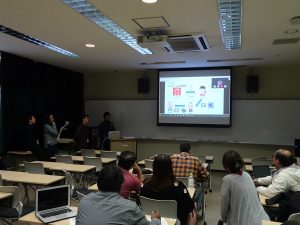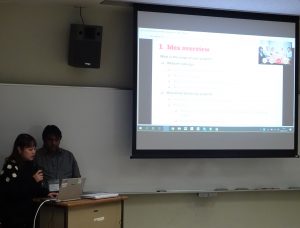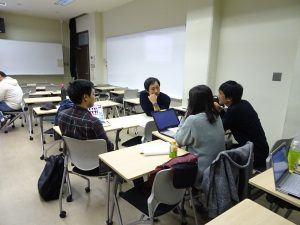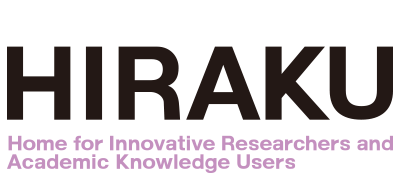 Innovation Practice – Week 6 Report
Innovation Practice – Week 6 Report
The sixth workshop for Innovation Practice was held on Wednesday, November 13, 2019 at K202, Graduate School of Integrated Arts and Sciences, Higashi-Hiroshima Campus. We had 11 participants in total from undergraduate, doctorate students to Special Postdoctoral Researchers on site. We also had a few Skype participants from the proposing company, Hirotuku Co., Ltd. to get their feedback to the med-term presentations. Each group was given 15 min to update their progress (10min. for presentation, 5min. for Q&A)
 The first group “FuwaFuwa” proposed a business model to target Muslim community as end-users. To promote Hirotuku Tsukudani to Muslim Community, they propose to make the company website user-friendly for international residents, to improve package designs and to get the Haral certificate, etc. They were planning to approach international students at HU first, expecting them to eventually promote the products through their international network.
The first group “FuwaFuwa” proposed a business model to target Muslim community as end-users. To promote Hirotuku Tsukudani to Muslim Community, they propose to make the company website user-friendly for international residents, to improve package designs and to get the Haral certificate, etc. They were planning to approach international students at HU first, expecting them to eventually promote the products through their international network.
 The second group “Innovators” proposed a business model targeting the youth. They designed a test website, to make it user-friendly and cool to the youth with multilingual support. They had also run the survey to ask for the preference of the young generation. They were proposing to test selling Tsukudani at the university canteen, to expand the potential customer base from Hiroshima University to other universities, ultimately to establish Tsukudani as “Taste of Life” as Japanese food.
The second group “Innovators” proposed a business model targeting the youth. They designed a test website, to make it user-friendly and cool to the youth with multilingual support. They had also run the survey to ask for the preference of the young generation. They were proposing to test selling Tsukudani at the university canteen, to expand the potential customer base from Hiroshima University to other universities, ultimately to establish Tsukudani as “Taste of Life” as Japanese food.
 The third group “GIFTs (Great Innovation For Tsukudani)” made two proposals, to sell Tsukudani with “monetized” messages and to add value to Tsukudani as a GIFT. It was a business model to leverage the Japanese custom to send seasonal gifts, such as summer gift, winter gift, etc. They are proposing to print senders’ messages on the gift package as ad-value, ultimately to connect people with warm experience.
The third group “GIFTs (Great Innovation For Tsukudani)” made two proposals, to sell Tsukudani with “monetized” messages and to add value to Tsukudani as a GIFT. It was a business model to leverage the Japanese custom to send seasonal gifts, such as summer gift, winter gift, etc. They are proposing to print senders’ messages on the gift package as ad-value, ultimately to connect people with warm experience.
Representatives from Hirotsuku gave lots of questions and feedback to each team, which has helped all identify the areas for improvement. Additional Q&A session followed amongst the groups, so that they can ask questions each other to identify the core values of each proposal as well as the bottleneck they have to clear off to make their proposals more convincing and realistic. Putting all the above lessons learned into consideration, each group discussed further to refine their business models, based on the precise requirement for the final presentation scheduled two weeks after.




